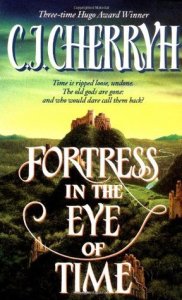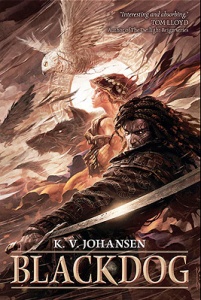Interview – K.V. Johansen
To celebrate the release of ‘The Lady’ today, I had a chat with the author K.V. Johansen about the previous two books in this world, ‘Blackdog’ and ‘The Leopard’ and much more.
About the author

K. V. Johansen was born in Kingston, Ontario, Canada, where she developed her lifelong fascination with fantasy literature after reading The Lord of the Rings at the age of eight. Her interest in the history and languages of the Middle Ages led her to take a Master’s Degree in Medieval Studies at the Centre for Medieval Studies at the University of Toronto, and a second M.A. in English Literature at McMaster University, where she wrote her thesis on Layamon’s Brut, an Early Middle English epic poem. While spending most of her time writing, she retains her interest in medieval history and languages and is a member of the Tolkien Society and the Early English Text Society, as well as the SFWA and the Writers’ Union of Canada. Her previous works for adults include the Sunburst-nominated Blackdog and the short story collection The Storyteller. She is also the author of two works on the history of children’s fantasy literature and a number of books for children and teens, including the award-winning Warlocks of Talverdin and Torrie series. Various of her books have been translated into French, Macedonian, and Danish. Visit her online at www.kvj.ca
Welcome on Draumr Kopa! Can you tell us a bit more about yourself and your work so far?
Thanks for the invitation to be on your blog!
I live on the east coast of Canada and have degrees in English and Mediaeval Studies. I write for children, teens, and adults, mostly novels, but I also have a picture book series, two short story collections, and two semi-academic non-fiction books on the history of children’s fantasy literature. My novels (and short stories) are mostly fantasy, with one children’s series that is near-future science fiction. Recently, I’ve been concentrating on novels for adults with the three works set in the Blackdog world.
What are your favourite books?

I have lots of favourites. The Lord of the Rings heads any list of my favourite books. Some of the other fiction that I go back to reread frequently or that has lingered with me or shaped my idea of what a story should do includes Kim (Kipling); The Lantern-Bearers and The Eagle of the Ninth (Sutcliff); Stewart’s three Merlin books; all Ransome’s Swallows and Amazons books; Howl’s Moving Castle (DWJ); Greenmantle (Buchan); Gaudy Night (Sayers); Donald Jack’s Bandy Papers series, especially the first three books; Glen Cook’s Black Company series; Len Deighton and Cold-War era LeCarré ; Scott and Yeats; Memory and Paladin of Souls (Bujold); McKillip’s Riddle-Master trilogy; Fortress in the Eye of Time (Cherryh) and her Chanur series; The Hero and the Crown (McKinley). Harold Lamb is a more recent discovery I’ve really enjoyed and found making me look at some things I’m doing from a different angle. Favourite non-fiction would be another list, but there are some I reread as much for the language and the overall impact of the work and the author’s approach to the subject as for my interest in the particular topic.
There are some interesting recommendations in there! Now an interesting question for aspiring writers: how did your road to publication look like?
I always told stories to my sisters and eventually started writing them down, and I always figured that whatever else I did, I would be writing at the same time. My first book published was a children’s novel, Torrie and the Dragon, which was written when I was twenty and published when I was very nearly thirty, so there were a lot of rejections in there! Even while I was writing children’s novels and picture books, though, I was always working on adult fantasy at the same time; it just happened to be the children’s books that found publication first.

“The Leopard” has a very unique structure, the main characters seem to walk in and out of the story, shifting the focus to new main characters. Why choose this kind of structure instead of a more conventional one where we follow the same characters from beginning ‘till end?
The Leopard and The Lady are actually one book, Marakand, which was split into two volumes because of the length; the structure makes more sense when you put the two halves together. Have faith! The Lady will be out soon …. (today!)
It’s an interlaced narrative following several character clusters and several individuals within each group. For much of the time, the action is also taking part in two places at quite a geographical remove from one another. Because of the time certain things take to happen, the story sometimes leaves one group for quite a while to concentrate on what’s going elsewhere. The story ended up being quite a complex one that I couldn’t tell by focusing on only a couple of people; I suppose in part because it is several entangled stories — Moth’s hunting of the devils, Ahjvar’s curse and deathwish, Zora’s story and the Lady’s too, Marakand’s conquest of Deyandara’s tribe and the reasons for that, Deyandara’s sense of duty to her aunt’s conquered people, the rebellion in Marakand, the mystery of Ghu, what happened to Holla-Sayan after the end of Blackdog, Ivah trying to atone for her past . . . there was just too much to tell through following only one or two characters.
Deities, demons, etc and faith are quite central in the story. Do you think it is important to give the world you created a certain religion and have this good vs evil undercurrent?
For the stories set in this world, the many gods and organized religions (and many gods don’t have an organized religion in the Blackdog world, though that doesn’t mean they aren’t worshipped) are an essential part; they’ve been the foundation of the story from the start, with the incarnate goddess Attalissa being the catalyst of the story in Blackdog. The local gods and goddesses, their relationships with the people of their own small territories, and humans’ relationships with their gods, with the nature-spirit demons, who are very like the gods but have a different role in the world, and with the Old Great Gods whose concern is the souls of the dead, are all what shape how this world works and make it distinct — the stories arise out of that cosmology. I’m not sure that there is a good versus evil that can be broken down into anything to do with religion or gods and demons, though. Most gods of the earth are fairly benevolent, though in The Leopard and The Lady there are one or two who do evil as humans do, convinced that they have the right to dispose of other’s lives, or serving some need or desire of their own and justifying it to themselves. Even the devils, the legendary enemies of gods, humans, and demons, some of whom have done and do do great evil, aren’t monolithic in their nature. The good and evil is usually individual, not something you can be certain of because of what the character is, god or human or demon or devil.

You’ve also written “Blackdog”, whose characters make an appearance in “The Leopard”. Can we see that book as a kind of prequel to the Marakand series? And is it essential to read it to understand what’s happening in “The Leopard”?
The Leopard can be read without Blackdog, despite the overlapping characters. It shares some history, and is set about a year after Blackdog ends, taking place farther east on the caravan road. It’s the story of the curse on the assassin Ahjvar, the rebellion in Marakand, and Deyandara’s people’s fall to Marakand. In a way, Holla-Sayan, the hero of Blackdog, just ends up in it because he’s in the city at the time … and yet, because of what he is, he is deeply concerned in the larger story beneath the surface of rebellion against the Lady. Moth and Mikki wander into other people’s stories on their longer quest — Holla-Sayan’s in Blackdog, Ahjvar’s in The Leopard and The Lady. So the short answer is, The Leopard can be read without Blackdog, but reading Blackdog enriches The Leopard. And The Lady is the second half of The Leopard, so those two really must be read together. (Just think of them as Marakand Part One and Part Two, like the mass market paperback of To Green Angel Tower, if you remember the nineties!)
Powerful, strong women are definitely a big part of your story. Do you think it is important to make these characters more prominent in SFF?
It’s definitely important that there be both women and men who are real, full characters in any kind of book, whether they’re confined to primary-world cultural roles determined by their sex or not. Certain streams of fantasy have tended too often to treat female characters as set decoration rather than people in the story, and to use about three stock female paper dolls. Even if I were writing historical fiction, or writing a fantasy in which rigid sex-based social roles played a part, I would still have all the people being full, complex, people, strong personalities or weak ones as the story demanded of each character regardless of sex, but since I’m writing secondary world fantasy and have created a world without as many of those rigid definitions of who is allowed or supposed to do what type of thing, women end up in positions of political or religious power, or as the mysterious wandering warrior or caravan boss or whatever, quite naturally. I write what I like best to read, which is adventure and intrigue and people with murky and mysterious pasts, people getting themselves into desperate situations, people finding deep within themselves the strength to be heroic in the quiet as well as the dramatic ways, with both women and men in the thick of everything.
Maybe there is a bit of an urge to satisfy that ten-year-old who felt there weren’t enough females actually having the adventures in her favourite books, too.
I read you’re making a Manga-style adaptation of “Blackdog”, can we expect that in stores soon?
I wish I could say yes, but unfortunately it’s a project on hiatus for the time being. It’s actually the short story “The Storyteller” (from the collection of the same name) that is going to be a manga someday. That’s the story about when the seven devils first escaped their graves, and how Moth and Mikki ended up travelling together to avenge his mother, the bear-demon who was guardian of Moth’s grave. My artist friend Connie Choi and I started working on it back when she was in high school. Now she’s at art college, which doesn’t leave her much time for such a demanding independent project. We haven’t given up on the idea and we still talk and plan, but it’s hard to know when we’ll be able to get back to it.

Have you thought about Marakand as a movie? Do you already have actors or actresses lined up as favourites for your characters?
It would be lovely to see Marakand or Blackdog as a movie — or anime, I can really imagine that world as anime. Michelle Yeoh would make a great Yeh-Lin — she has the stunning looks as well as an ability to convey the combination of elegant physical strength and subtle emotion, as well as humour — but aside from that no-one really comes to mind. I don’t watch that many movies, I’m afraid.

The Lady is being published today, what can you tell us about it?
The Lady is the concluding part of Marakand, completing the story begun in The Leopard. It carries on right from where The Leopard left off, with the ongoing uprising in Marakand, then switches to Ghu following Ahjvar, to either save or destroy him, and continues to follow both stories, interweaving what’s happening in the city, where Zora, the Blackdog, and Ivah are, amid the rebellion against the Lady, with events Over-Malagru among the Praitannec tribes whose lands Marakand has invaded, where Ghu, Ahjvar, and Deyandara are. And Moth fought the Lady under the temple and was trapped there in The Leopard, so there’s that to sort out too.
Thank you so much for your time, it has been a pleasure!
Make sure you check out Blackdog (Amazon, TBD) and The Leopard (Amazon, TBD). The Lady is published today by Pyr Books (Amazon, TBD)!
Keep an eye out for my reviews of ‘The Leopard’ and ‘The Lady’ which will be online soon!



4 Comments
Paul Weimer
I think the Leopard/The Lady can be read without reading The Blackdog, but I think it works much better if you have, especially once Ahi and Ghu go offstage a bit and characters like Holla-Sayan and Mikki and Moth take the stage for a while.
Pingback:
Pingback:
Pingback: